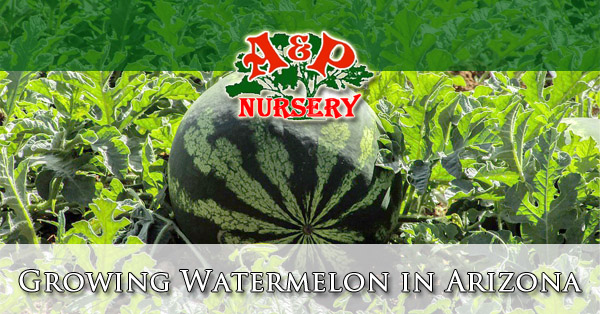
If you thinking of growing watermelon in Arizona, this article is for you. Watermelon is synonymous with summer and is served at just about every backyard BBQ and 4th of July party you go to. It is an easy-to-grow crop which yields incredible flavor and is one of the largest edible fruits.
Watermelon Seed Varieties
There are 4 main categories of watermelons that most people buy or grow today. These are icebox, picnic, yellow, and seedless watermelons. Icebox watermelons are the smallest which range from 5 to 15 pounds. Seedless watermelons are a little bigger and will usually grow to between 10 and 20 pounds. The picnic watermelon is the largest of them and will grow under the right conditions to between 15 and 20 pounds.
Watermelon Options
There is a wide variety of hybrid and heirloom seeds available to the Arizona home gardener which gives the power of choice for the pattern, color, size, and flesh colors. The flesh colors you eat can be the iconic bright red all the way to nearly white. Rinds are also available from dark or light green to mottled, stripped, or solid colors.
How To Grow Watermelon
Having your own fresh watermelon for the summer is a wonderful way to enjoy the fruits of your gardening labor. Planning the space you will need, variety of seeds, and knowing how to water your watermelon are some of the key points to success.
Soil Preparation
Watermelon needs to have good soil and fertilizer to grow well. Soil should be amended with organic matter like compost or animal manure. Soil should also be enriched with fertilizer which is well balanced and rich with nitrogen.
Watermelon Vine Spacing
Watermelon vines are known for growing quickly and spreading out. They can reach lengths up to about 20 feet. This means you need to choose areas in your landscape that afford room to your watermelon. Avoid planting too close to other crops or ornamental plants as the vine might fight for space. There should be about 4 feet between your watermelon seed plants in a row, and 8 feet between rows. Space is a challenge in growing watermelon, start out with plenty and you’ll thank yourself.
Planting Your Seeds
Once you have chosen the seeds you want to plant from your local nursery you need soil that isn’t too cold. It is best to wait until the soil is 70°F or warmer, which isn’t typically a problem in Arizona. The soil needs to be warm for the seeds to properly germinate and grow. Small hills should be made and about 9 seeds should be pushed 1 inch deep in the top of each of the hills.
Watermelon Watering
Watermelons have deeper roots than most people expect and need to be watered deeply. This is especially important in the desert heat of Arizona. Soil probes can be purchased to keep track of how deeply the soil is saturated. Keeping track of your watering schedule helps create plans that are easy to follow and will help you be successful.
Harvesting Your Watermelon
Once the work and wait is done it is time to enjoy your watermelon, but knowing when they are ready can be tricky. In hot summer weather when watermelon are generally being grown it only takes about 32 days for the watermelon to be ripe after the plant blooms.
How To Tell When Watermelon Is Ripe
Tendril Ripe – Many experienced gardeners watch for a tendril which is located closest to the main stem. A tendril is a stem of modified leaf which grows as a spirally slender coil. As soon as this tendril dries up and turns brown your watermelon is ripe.
Sound Ripe – Another method a lot of people like is tapping on the watermelon and waiting for a nice soft hollow sound. They do this by slapping, tapping, or thumping their melons.
Appearance Ripe – One of the most reliable ways for gardeners to know when the watermelon is ripe to harvest is watching the bottom of the melon where they touch the ground. This spot many times starts as a near white look and will turn to a rich yellow as the watermelon matures. The skin of the watermelon also changes appearance from having a slick shiny surface to one that is more dull.
Watermelon Handling
Watermelons can be ruined with rough handling. They should never be dropped, bumped, or rolled. If gardeners are not careful with their watermelon there can be bruising of the flesh inside the watermelon.
Storing Watermelon
While watermelon is best served chilled, uncut watermelon need to be stored with temperatures between 60 and 70 degrees Fahrenheit. Watermelon which is exposed to temperatures above 90 or below 50 for too long will have deterioration of the flesh.
East Phoenix Valley Gardening Supply
A&P Nursery has been planting, growing, and harvesting plants in Arizona for many years. We have the knowledge, right tools, fertilizers, and everything you need to get started in growing watermelon here in Arizona. We can help you plant the type you want, where to plant them, and help you understand how to keep them watered and fertilized for the best results. Call or stop by one of our 4 east valley locations today!
A & P Nursery
40370 N. Gantzel Rd.
Queen Creek, AZ 85240
480-655-5789
A & P Nursery
2645 W. Baseline Rd.
Mesa, Arizona 85202
480-839-5362
A & P Nursery
6129 E. Brown Rd.
Mesa, Arizona 85205
480-396-8800
A & P Nursery &
Lawnmower Shop
2601 E. Baseline Rd.
Gilbert, Arizona 85234
480-892-7939